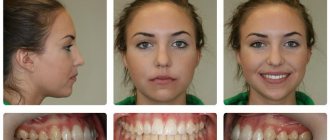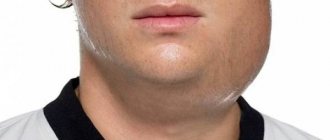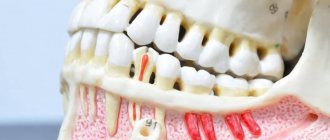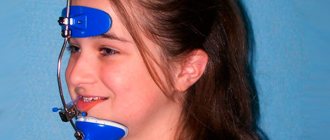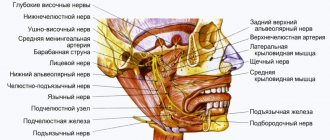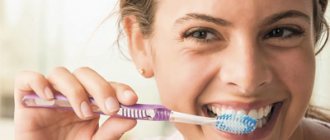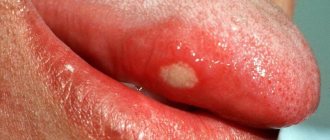Hemifacial spasm was first described by Gowers in 1884 and is a segmental myoclonus of muscles innervated by the facial nerve. The disease occurs at the age of 50-60 years, almost always on one side, although sometimes, in severe cases, there is bilateral damage. Hemifacial spasm usually begins with short clonic movements of the orbicularis oculi muscle and over the course of several years affects other facial muscles (frontal, subcutaneous, zygomatic, etc.).
Clonic movements gradually progress to sustained tonic contractions of the involved muscles. Chronic irritation of the facial nerve or nucleus (which is considered the main cause of hemifacial spasm) can occur due to various reasons.
The muscles of the face are susceptible to the same movement disorders as the muscles of the limbs or trunk. Myoclonus, dystonia and other movement disorders manifest themselves in the form of specific syndromes in the facial muscles. A clear understanding of the mechanism of development of disorders allows for correct diagnosis and selection of adequate treatment.
Causes of hemifacial spasm include vascular compression, nerve compression from mass lesions, brainstem lesions from stroke or multiple sclerosis, and secondary causes such as trauma or Bell's palsy.
Although there are various treatments for craniofacial movement disorders, chemodenervation with botulinum toxin has proven to be very effective in treating these disorders, outperforming both medical treatment and surgical treatment in some cases.
Stimulation of the facial nerve nucleus is thought to result in hyperexcitability of the nucleus, while stimulation of the proximal nerve may result in ephaptic transmission within the facial nerve. This mechanism explains the rhythmic, involuntary myoclonic contractions that occur with hemifacial spasm.
Compressive lesions (eg, tumor, arteriovenous malformation, Paget's disease) and noncompressive lesions (eg, stroke, multiple sclerosis, basilar meningitis) may present with hemifacial spasm. Most cases of hemifacial spasm, previously considered idiopathic, were probably caused by abnormal blood vessels and compression of the facial nerve within the cerebellopontine angle.
Epidemiology
Hemifacial spasm occurs in people of different races with equal frequency. There is some predominance of this disease in women. Idiopathic hemifacial spasm usually develops in the fifth or sixth decade of life. The development of hemifacial spasm in patients younger than 40 years of age is unusual, and is often a symptom of a neurological disease (eg, multiple sclerosis).
Causes of jaw clenching during trismus
- inflammation of the masticatory muscles;
- inflammation of the gums;
- caries;
- abscess;
- inflammation of the periosteum of the lower jaw;
- jaw injuries (cracks, fractures, dislocations);
- dousing with cold water;
- animal or insect bites.
Trismus can also be a consequence of the following diseases:
- osteomyelitis of the jaw;
- periostitis;
- neurosis;
- epilepsy;
- meningitis;
- hysteria;
- arthrosis of the jaw joint;
- cancerous tumors;
- convulsions;
- rabies;
- tetany;
- paralysis;
- tetanus;
- pulpitis in the acute stage, etc.
What to do if the lower jaw is inflamed
First of all, it is important to identify the symptoms of the problem. One of the very first and most obvious is an increase in soft tissue volume.
This can be either a slight swelling or a very large tumor-like formation. Other symptoms may include:
- Increased body temperature.
- Redness of the skin.
- Painful sensations.
- Incomplete opening or closing of the jaw.
- Sensation of a foreign body in the throat.
- Difficulty chewing or swallowing.
- Hearing loss.
If the symptoms are confusing and it becomes unclear which doctor you need to see, you can make an appointment with a therapist who will conduct an initial examination, examine the complaints and issue a referral to the right specialist.
The main stages of trismus
- third - a person can open his mouth 10 mm, the most difficult stage;
- second - the patient can open his mouth 10-20 mm;
- first - the patient opens his mouth 30-40 mm, respectively.
In all cases, a person should immediately consult a doctor. You may need treatment in a hospital setting. In the process of clenching the jaw, there is a high probability of damage to the gums and chipped teeth. If help is not provided in time, oxygen starvation may occur.
Dental diagnosis of trismus involves:
- visual examination of the patient;
- to unclench the jaw, the dentist injects a drug that relaxes the muscles;
- To make the diagnosis more comfortable for the doctor and patient, an anesthetic drug is also administered;
- In addition to the dentist, you may need to consult a neurologist, surgeon, or traumatologist.
Myalgia
Causes
The main causes of myalgia are usually:
- infections;
- pathologies of the vascular system;
- unstable psycho-emotional state;
- depression;
- disturbances in the functioning of the endocrine system;
- injuries;
- long-term exposure to toxic substances (occupational hazards, drug therapy).
Clinical picture
The clinic of myalgia of the masticatory muscles is described taking into account the stage of development:
- pain that manifests itself during chewing and talking, that is, when moving;
- sharp pain at rest;
- the development of an inflammatory process, which is aggravated by the formation of intramuscular nodes against the background of poor local blood supply, can be aseptic and septic;
- muscle damage;
- chronic pain syndrome (observed with muscle contracture), requiring constant relief with analgesics.
Pain is classified according to the following criteria:
- place of origin - may be localized or diffuse;
- course - acute or chronic;
- level of the enzyme creatine phosphokinase (abbr. CPK) - increased or within normal limits;
- pathological changes in tissues - fibromyalgia (symmetrical pain of a predominantly non-inflammatory nature, aggravated by movement), myositis (inflammation in the muscles against the background of a viral, bacterial or other infection).
Diagnosis and treatment
Diagnosis of myalgia of the masticatory muscles involves:
- kinesthetic study (examination during which hypertonicity and muscle atrophy are detected);
- electromyography (carried out by installing body or needle electrodes through which current is supplied);
- magnetic resonance imaging (necessary to identify fibrosis and assess the severity of the pathological process).
Treatment is based on an integrated approach, including drug therapy (non-narcotic analgesics, muscle relaxants, non-steroidal anti-inflammatory drugs, antiparasitic drugs). Physiotherapy helps to achieve a good effect. Our specialists in the treatment of myalgia use manual therapy methods that help level out dystrophic lesions in muscle tissue and relieve increased muscle tone. Thanks to massage, it is possible to improve blood microcirculation, thus providing the tissues with the necessary nutrition. Physical therapy is prescribed after pain relief; a set of exercises is compiled on an individual basis.
How to properly treat trismus of the masticatory muscle?
Treatment of the problem involves:
- immobilization of the jaw by applying a bandage or splint;
- eliminating the underlying cause of trismus (disease or specific condition);
- taking neuropsychic stimulants and sedatives;
- a course of taking muscle relaxants;
- a course of antibiotics (for inflammatory processes);
- physiotherapy;
- peace and release from physical work.
If the patient’s condition is severe, observation in a hospital is necessary under the supervision of a maxillofacial surgeon, neurologist, traumatologist, etc.
After eliminating acute symptoms, a person is recommended a special diet:
- plenty of fluid;
- chopped food;
- vegetables and fruits;
- natural juices.
If it is impossible to eat normally, food is supplied through a tube, and liquid is supplied through the skin.
To restore the functions of the masticatory muscle, the patient is recommended to perform special therapeutic and preventive exercises.
It is important to completely cure trismus, and not just suppress its symptoms. If the cause is not removed, the problem will reoccur. Spasms put a powerful strain on the teeth, gums, and nervous system. It is very important to contact an experienced dentist with a surgical profile, who will help cure the disease and tell you what to do in emergency situations. The 32 Dent network of clinics in Moscow employs specialists who will provide such comprehensive assistance for trismus of the masticatory muscle and other serious problems.
If you have a problem similar to that described in this article, be sure to contact our specialists. Don't diagnose yourself!
Why you should call us now:
- We will answer all your questions in 3 minutes
- Free consultation
- The average work experience of doctors is 12 years
- Convenient location of clinics
Single contact phone number: +7
Make an appointment
Symptoms
Involuntary movements of the facial muscles are the only symptom of hemifacial spasm. Fatigue, anxiety or reading can speed up movements. Spontaneous hemifacial spasm involves facial spasms, which are myoclonic spasms and are similar to segmental myoclonus, which can occur in other parts of the body. Postparalytic hemifacial spasm, such as after Bell's palsy, manifests as facial synkinesis and contracture.
There are a number of conditions similar to hemifacial spasm.
Spasm of the masticatory muscle
Hemispasm of the masticatory muscle is similar to hemifacial spasm and occurs when the motor trigeminal nerve is irritated. This is a rare condition that is segmental myoclonus, and is manifested by unilateral involuntary contractions of the muscles innervated by the trigeminal nerve (mastication). As with hemifacial spasm, hemispasm of the masseter muscle is well treated with medication and botulinum toxin. In addition, there is evidence that surgical treatment may be effective in some cases.
Myoclonic movements
Myoclonic movements in the facial muscles can also occur with lesions of the brain or brain stem. They differ from hemifacial spasm in the distribution of abnormal movements (more generalized, possibly bilateral), and can be diagnosed by neurophysiology. Imaging techniques can reveal deeper causes. Central myoclonus responds well to anticonvulsant therapy.
Oromandibular dystonia
Oromandibular dystonia is a muscular dystonia that affects the lower musculature of the face, primarily the jaw, pharynx and tongue. When oromandibular dystonia occurs in combination with blepharospasm, it is called Medge's syndrome.
Botulinum therapy is most effective in the treatment of oromandibular dystonia. Medications are also used to a certain extent for oromandibular dystonia.
Craniofacial tremor
Craniofacial tremor may be associated with essential tremor, Parkinson's disease, thyroid dysfunction, and electrolyte imbalances. This condition rarely occurs in isolation. Focal motor seizures sometimes need to be distinguished from other facial movement disorders, particularly hemifacial spasm. Postictal weakness and increased involvement of the lower face are hallmarks of focal motor seizures.
Chorea of the face
Facial chorea occurs in the context of a systemic movement disorder (eg, Huntington's disease, Sydenham's chorea). Chorea is an episodic complex of movements without a pattern. A similar condition, spontaneous orofacial dyskinesia, occurs in older edentulous people. As a rule, the installation of prostheses gives a good effect.
Tiki
Facial tics are short, repetitive, coordinated spontaneous movements of grouped muscles of the face and neck. Tics may occur physiologically or due to diffuse encephalopathy. Some medications (eg, anticonvulsants, caffeine, methylphenidate, antiparkinsonian drugs) may cause tics. Single, repetitive, stereotypical movements are characteristic of tics.
Facial myokymia
Facial myokymia manifests itself as worm-like twitching under the skin, often with a wave-like distribution. This condition is distinguished from other abnormal facial movements by the characteristic EMG discharges, which are short, repeated bursts of motor unit potentials in the range of 2-60 Hz, with periods of silence of up to several seconds. Facial myokymia can occur with any process in the brain stem. Most cases of facial myokymia are idiopathic and resolve on their own within a few weeks.
How long does it take to cure trismus?
Typically, full muscle recovery can take one to three weeks, depending on the cause of the trismus. More time will be needed for fractures of the jaw, which must heal properly and subsequently develop.
To prevent trismus of the masticatory muscle, you must:
- do not cause diseases of teeth and gums;
- get vaccinated against rabies and tetanus (rabies and, as a result, lockjaw can be fatal);
- In case of blows or damage to the jaw, seek emergency help from dentistry;
- avoid stressful situations, nervous tension;
- when engaging in contact sports, wear special helmets and mouthguards for protection;
- undergo regular preventive examinations with a trusted dentist. These are the doctors who work in the 32 Dent network of clinics, where you will be happy to see you at any time. Contact us!
Treatment of peritonsillar abscess
In case of a complicated course, children (especially young children) are indicated for hospitalization and treatment in a hospital setting.
The main treatment method for PTA is systemic antibacterial therapy. In severe cases, severe intoxication, difficulty swallowing, nausea, antibacterial therapy is prescribed parenterally (bypassing the gastrointestinal tract) with subsequent transfer to oral forms of drugs - until the completion of the 14-day course of treatment. Courses of antibiotic therapy for less than 10 days increase the likelihood of disease relapse.
After prescribing systemic antibiotic therapy, dynamic observation for 24 hours is recommended. It is acceptable in patients with suspected paratonsillitis, without obvious signs of PTA, without signs of airway obstruction, sepsis, severe spasm of the masticatory muscles, or other signs of a complicated course of the disease. And also in children under 7 years of age with small abscesses and rare episodes of acute tonsillopharyngitis in history.
Studies have shown that systemic antibiotic therapy is effective even without draining the abscess. According to available data, 50% of children responded to systemic antibiotic therapy and did not require abscess drainage or tonsillectomy.
Systemic antibacterial therapy should include antibiotics active against GABHS, Staphylococcus aureus and respiratory anaerobes. For PTA, amoxicillin-clavulanate, ampicillin-sulbactam, and clindamycin are most often prescribed. If there is no or severe response, vancomycin or linezolid is added to treatment to ensure optimal coverage of potentially resistant Gram-positive cocci.
Diagnosis and treatment of jaw inflammation at the dentist in Odintsovo
If inflammation of the jaw has developed due to diseases such as pulpitis, periodontitis, periodontitis, as well as as a result of injuries and damage to the temporomandibular joint, then the treatment will be carried out by a dentist. First, a specialist must establish an accurate diagnosis. To do this, he collects anamnesis, finds out complaints, and conducts a visual examination of the oral cavity. Additionally, an X-ray examination of the jaws, laboratory tests and other diagnostic tests may be prescribed, with the help of which it will be possible to obtain objective information about the condition of the patient’s dental system.
Treatment of inflammation in our clinic in Odintsovo is usually carried out using combined methods, which include:
- Conservative therapy. Typically, the dentist prescribes antibacterial, anti-inflammatory and painkillers.
- Surgery. It involves the removal of non-viable tissue, drainage of the inflammatory focus and, if necessary, other procedures that are aimed at eliminating the pathological area.
The duration and complexity of treatment largely depends on the degree of neglect of the process. The sooner a patient seeks medical help, the easier it will be to restore lost health.

